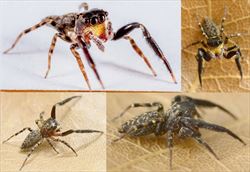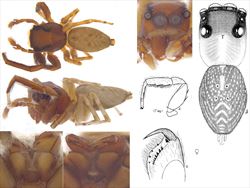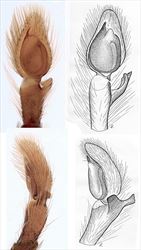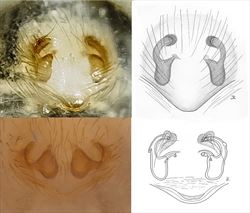
Examples of live Sondra
Illustrators (and ©) R. Whyte (TR) and M. Newton

Aspects of the general morphology of Sondra
Illustrators (and ©) B.J. Richardson (CSIRO), M. Zabka (diag,) (QMB)

Palp morphology of Sondra
Illustrators (and ©) B.J. Richardson (CSIRO), M. Zabka (diag.) (QMB)

Epigyne morphology of Sondra
Illustrators (and ©) R. Whyte (TL), B.J. Richardson (BL) (CSIRO), M. Zabka (diag,) (QMB)
Sondra Wanless, 1988
Taxonomy
Sondra has fifteen Australian species: Sondra aurea, S. bickeli, S. bifurcata, S. brindlei, S. bulburin, S. convoluta, S. damocles, S. excepta, S. finlayensis, S. littoralis, S. nepenthicola, S. raveni, S. samambrayi, S. tristicula and S. variabilis. The genus is part of an Australasian clade (Maddison et al 2008) including Adoxotoma, Arasia, Astia, Astilodes, Helpis, Jacksonoides, Megaloastia, Parahelpis, and Tauala. Genera from Indonesia (Katya) and the Philippines (Orthrus) may also be part of this group (Maddison 2015). Further information on the genus and described species can be found in Richardson and Żabka (2017) and Whyte and Anderson (2017).
Description
Sondra spp. are mostly small to medium-sized spiders, ranging in body length from 3 to 5 mm. The head, viewed from above, is roughly rectangular with rounded sides, widest behind the posterior lateral eyes. The carapace is high, peaking at the posterior median eyes. Chelicerae have many (plurident) retromarginal teeth and three or four widely-spaced promarginal teeth. The abdomen is elongate-ovate. The first pair of legs is a little longer and heavier than the others. The spines on the tibia and metatarsus of the first pair of legs are very well developed.
The male’s palp has a thin, short to medium-length embolus arising on the distal edge of tegulum, sometimes accompanied by a sclerite. The tegulum is rectangular to oval in shape, without a proximal lobe. The palpal tibia has a single, short, heavily built apophysis which varies widely in shape and size between species.
The female sometimes has a single, barely-discernible epigynal atrium. Copulatory openings on the lateral edges of the atrium lead into insemination ducts which travel in a latero-posteriorly curve to rounded, widely-separated spermathecae located near the posterior edge of the epigyne, which has a median caudal lobe.
Biology
Sondra is a common genus, mostly found in litter in rainforest and wet sclerophyll forest, occasionally in drier open forest.
Distribution
The genus occurs widely across the wetter areas of Australia in all States and Territories including Tasmania.
References
Davies, V.T. & Żabka, M. 1989, Illustrated keys to the genera of jumping spiders (Araneae: Salticidae) in Australia. Memoirs of the Queensland Museum 27, 189-266.
Gardzińska, J. & Żabka, M. 2010. A new genus and five new species of Astieae (Araneae: Salticidae) from Australia, with remarks on distribution. Zootaxa 2526: 37-53.
Maddison, W.P. 2015. A phylogenetic classification of jumping spiders (Araneae: Salticidae). Journal of Arachnology 43, 231-292.
Maddison, W.P., Bodner, M.R. & Needham, K.M. 2008. Salticid spider phylogeny revisited, with the discovery of a large Australian clade (Araneae: Salticidae). Zootaxa 1893, 49-64.
Richardson, B.J. & Żabka, M. 2017. Salticidae. Arachnida: Araneomorphae. Canberra, Australian Faunal Directory. Australian Biological Resources Study, at https://biodiversity.org.au/afd/taxa/SALTICIDAE.
Wanless, F.R. 1988. A revision of the spider group Astieae in the Australian Region. New Zealand Journal of Zoology 15, 81-172.
Whyte, R. & Anderson, G. 2017. A field guide to the spiders of Australia. Clayton: CSIRO Publishing 451pp.
Zabka, M. 2002. Salticidae (Arachnida: Araneae) from the Oriental, Australian and Pacific Regions, XV. New species of Astieae from Australia. Records of the Australian Museum 54, 257-268.
* The information sheet should be read in the context of the associated diagrams and photographs. Diagrams explaining anatomical terms can be found in the ‘Salticidae’ pictures at the beginning of the list of genera.